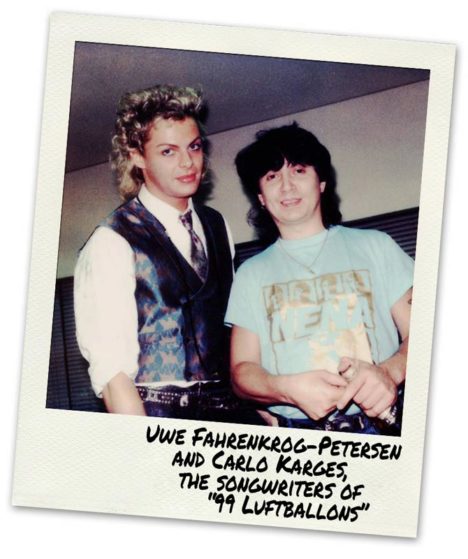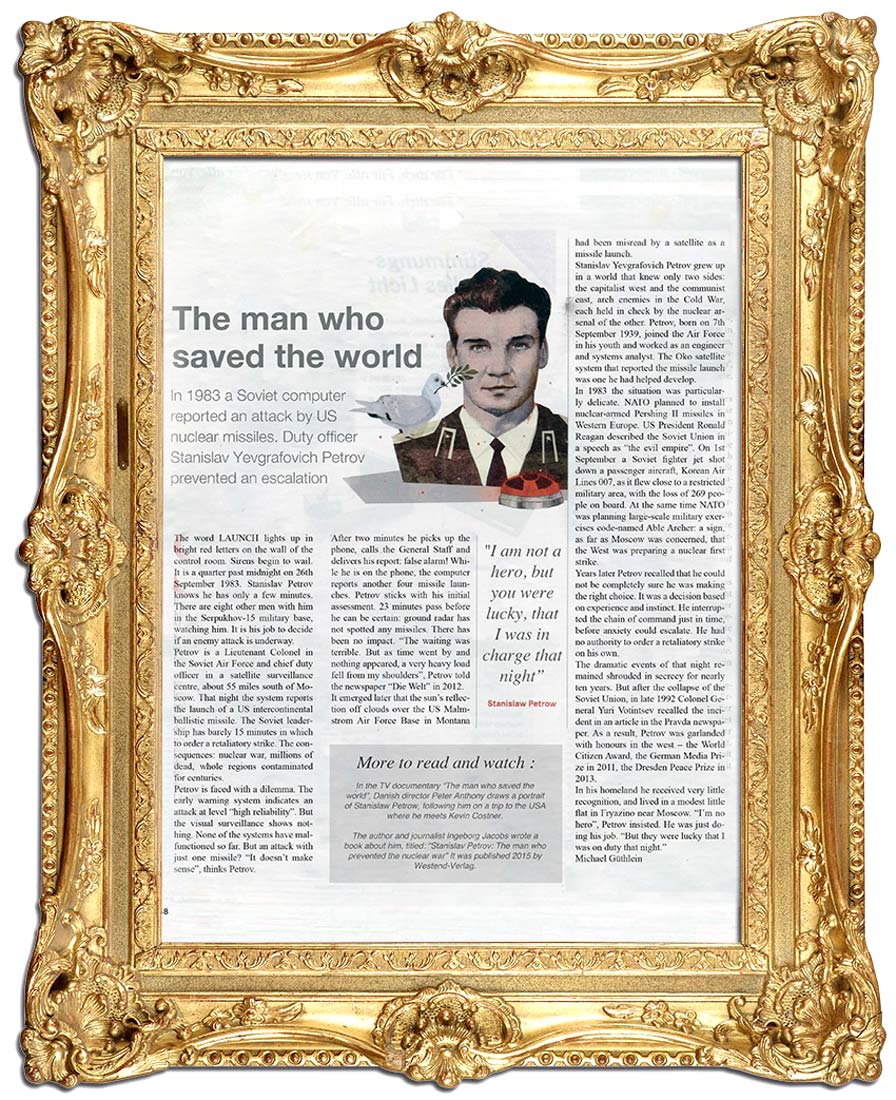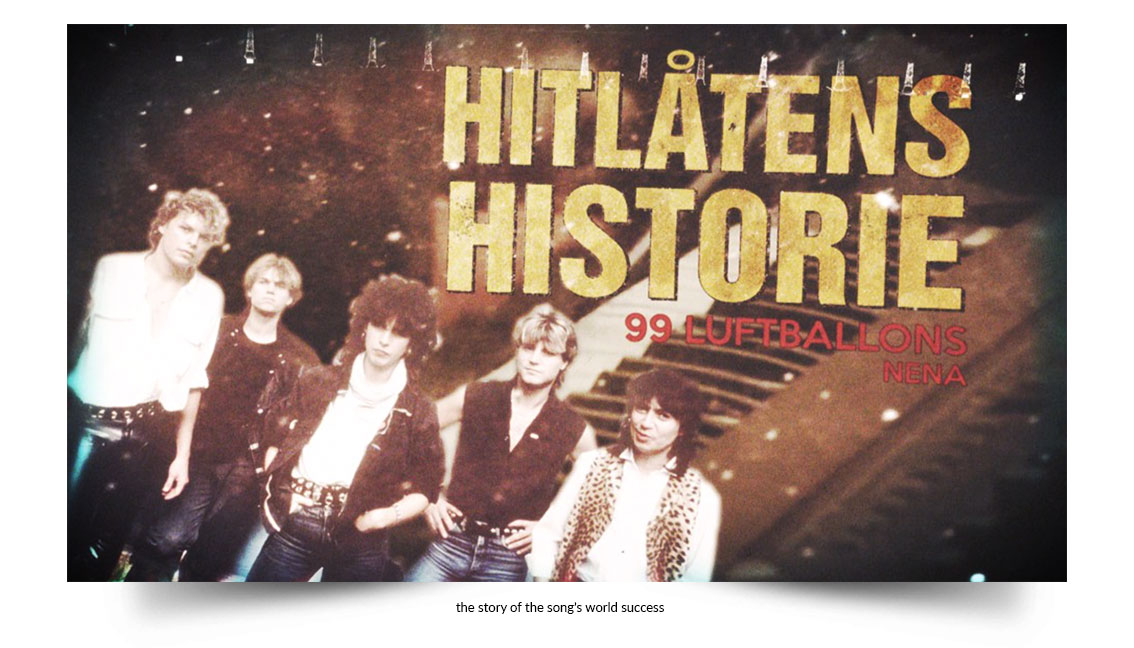Welcome
to the first and only comprehensive digital exhibition about 99 Luftballons (English title: 99 Red Balloons), one of the most remarkable and relevant songs in music history:
With an introduction by the song’s composer, Uwe Fahrenkrog-Petersen, with the story of the song’s conception, of its phenomenal international success, of its relevance then and its relevance today, and of the remarkable Berlin band that made the song famous. This was a song created in a pre-digital age, when the first polyphonic synthesizer sounds reverberated from record players, cassette recorders and radios, when excited fans dashed to the kiosk every week to get their hands on news, posters and cut-outs of their idols, and when two superpowers threatened each other, and the whole of humanity, with the prospect of nuclear Armageddon. It’s a song whose message is as relevant today as it was back then. There are people all over the world for whom it awakens memories of a special time in their lives, and it makes those moments live again.
Foreword
by Uwe Fahrenkrog-Petersen
When I composed the music for 99 Luftballons in autumn 1982, I never dreamed that it would become the most internationally successful German pop song in music history, and that today, 35 years later, it would still, through every conceivable medium, be listened to and appreciated all over the world.
Many other songs I wrote became international hits, but 99 Luftballons is still, for me, the most important one of my career.
For so many people in so many countries, that song defined a special time in their lives, as I know from the incredibly positive and heart-warming responses to it that still come my way. It saddens me that my great friend Carlo Karges, who wrote the original lyrics, is no longer with us, but 99 Luftballons still resonates around the globe and keeps his artistic legacy alive.

How did the song 99 Luftballons
come to be written?
It was 1982, the height of the Cold War, and I was 22 years old. In my home city of West Berlin, the shadow of nuclear war hung over us every day, and I and my fellow members of the band NENA knew that, if war came, we were sitting right in the bullseye. We were part of the New German Wave that was shaking up the Berlin music scene of the early 80s: I had already written the music for our first hit Nur geträumt (Just a Dream), and was hard at work day and night in the rehearsal studio, trying out new sounds and ideas on my OB-X synthesizer.
Inspired by Stevie Wonder, I composed a Unisono synth bass riff, with a hard funky sound that really appealed to me. The question was: how to make it work in a German New Wave pop song?
A few days later I was driving to a band rehearsal, and I had this great melody in my head which wouldn’t go away. As soon as I arrived at the studio, I recorded an instrumental demo on cassette so I wouldn’t forget it. I knew the tune – and the funky synth bass riff – were both, in their way, original. But could they fit together?
I remember how excited I felt, trying both ideas out on our drummer Rolf Brendel and my long term friend and collaborator, bass guitarist Jürgen Dehmel. It was Jürgen who encouraged me, saying we should try them out together. The switch from halftime funk to fast punk pop was way out of the ordinary, but he seemed to think it would work. Sure enough, the combination had a magic that we felt at once. By the time our guitarist – and rock’n’roll poet – Carlo Karges walked in, we were experimenting with something really unique. He listened for a while, fascinated, then started rummaging around in the black ring binder in which he scribbled his lyrics. With a mischievous smile he told us that some words he had written a few weeks before would fit my tune exactly!
The idea had come to him when we were all attending a Rolling Stones open air concert in the Berlin Waldbühne in the summer of 1982. The Stones finished, as they did every concert, by releasing a vast quantity of helium balloons into the sky. Within minutes, Carlo realised, those balloons would be detected by Soviet radar in one of the Russian missile platforms stationed around Berlin ….
Would Russian radar control be smart enough to spot the difference between a bunch of harmless balloons and a swarm of short-range nuclear missiles?Or would they press the red button, launch a counter attack and accidentally bring about worldwide nuclear annihilation? To Carlo, the lyrics this incident inspired were a metaphor for the fear and paranoia that can often scar human relations. For me they were a godsend. It was an extraordinary coincidence. My melody had an unusually large number of notes, but Carlo’s words fitted them perfectly. There was just one problem: his text was too long! He had written six whole verses! We cut one verse with a heavy heart, but it was still too much text for a pop song. The music might get too repetitive …
Then I had an idea: what if the first and last verses had no drums, no guitars, no bass? Just epic synth chords. The prologue and the epilogue, so to speak. We tried it out straight away and immediately the song was more dynamic, the words more expressive. That whole song – music and lyrics – sprang into life in one afternoon in the rehearsal room. Our vocalist Gabriele Kerner was immediately hooked. We had adopted her nickname NENA for the band, following the example of BLONDIE (Debbie Harry) in the States. “Nena’s” voice and punk girl attitude were the perfect fit for the supercharged music and the dark subtext of the lyrics. We were all convinced we had created something special. And we couldn’t wait to release it as a new single with our first album. But our record company CBS didn’t see it that way! They had no intention of releasing the song as a single. They said it didn’t fit any of the “conventional criteria” for a pop hit: it had no chorus, and it had a long instrumental section near the start. How could a song like that ever be successful on the radio? But we stuck to our guns, and though CBS was sure that our first, hard-earned success with Nur geträumt was about to go down the pan, they agreed to release the song.
The rest, as they say, is music history.
Uwe Fahrenkrog-Petersen
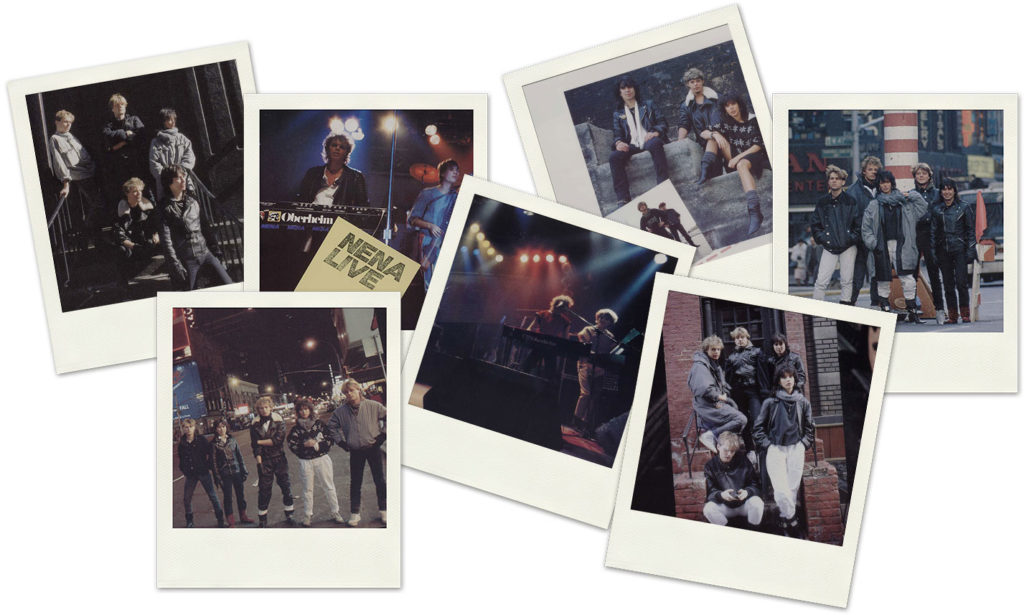
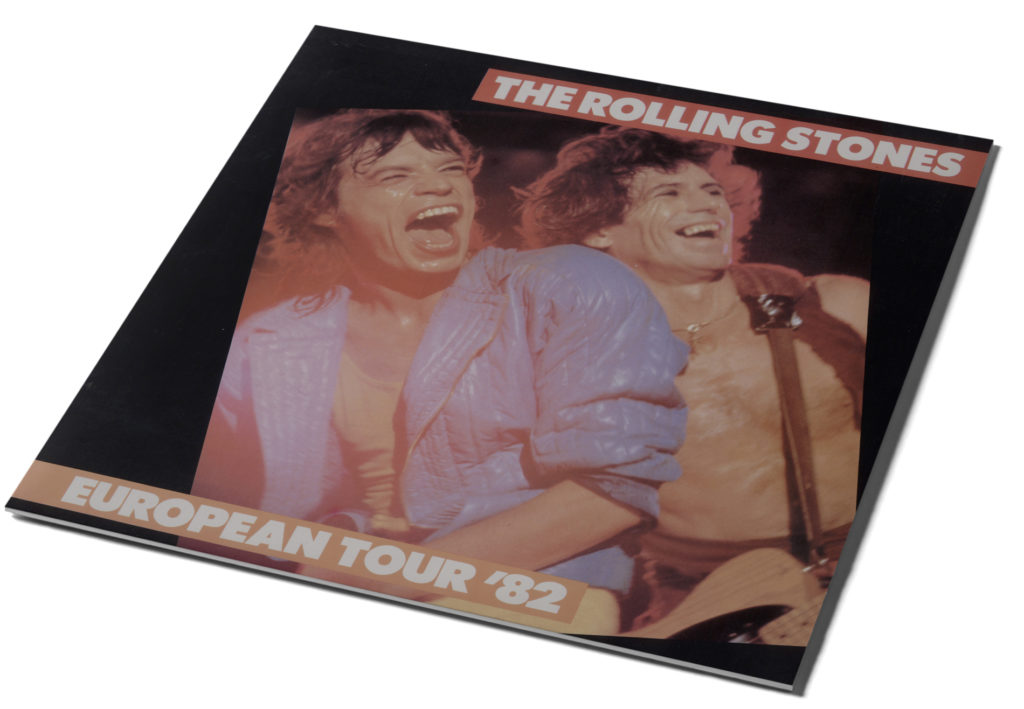
“99 Red Balloons“
Original lyrics by Carlo Karges /
English lyrics by Kevin McAlea
[verse 1]
You and I in a little toy shop
Buy a bag of balloons with the money we’ve got
Set them free at the break of dawn
‘Til one by one, they were gone
Back at base, bugs in the software
Flash the message, “Something’s out there”
Floating in the summer sky
99 red balloons go by.
[verse 2]
99 red balloons floating in the summer sky
Panic bells, it’s red alert
There’s something here from somewhere else
The war machine springs to life
Opens up one eager eye
Focusing it on the sky
Where 99 red balloons go by.
[verse 3]
99 Decision Street
99 ministers meet
To worry, worry, super-scurry
Call the troops out in a hurry
This is what we’ve waited for
This is it boys, this is war
The president is on the line
99 red balloons go by.
[verse 4]
99 knights of the air
Ride super high tech jet fighters
Everyone’s a silver hero
Everyone’s a Captain Kirk
With orders to identify
To clarify and classify
Scramble in the summer sky
99 red balloons go by.
99 red balloons go by.
[verse 5]
99 dreams I have had
In every one a red balloon
It’s all over and I’m standing pretty
In this dust that was a city
If I could find a souvenir
Just to prove the world was here
And here is a red balloon
I think of you and let it go.
A sensation for all fans of the song!
The never before released original demo of 99 Red Balloons.
“On the original demo, the melody is in C Major. Later I transposed the song into E Major to give a better range for the singer and the guitar. But for now, I was in a hurry to record the melody and harmonies that had been going around in my head as I drove to the studio. First I programmed a simple beat and sequence on my Fricke Step Sequencer. Then played over that live on my Oberheim OB-X and recorded it all together on two tracks of a Tascam 4 Track cassette recorder. Then I overdubbed the chords on the remaining two tracks. With the band a few days later, as I’ve described, I then added the synth riff I’d composed earlier.”
Uwe Fahrenkrog-Petersen

Production
The band NENA recorded 99 Luftballons and the other songs on their first album (which was also entitled NENA) in autumn 1982 in the SPLIFF recording studio in Berlin-Moabit. For the production team of Reinhold Heil and Manne Praeker it wasn’t the toughest of assignments. The band was well prepared and rehearsed, and the song’s arrangement was flawless. It was now up to the musicians to deliver a barnstorming performance, and up to the producers, with mix engineer Udo Arndt, to create a wild and fabulous soundscape without overshadowing the song’s special magic with too many technical effects. The tracks were recorded in the Spliff Studio by engineer Imre Sereg on a 24 track Otari tape machine via a Soundcraft desk, then mixed in the Audio Sound Studio in Berlin by Udo Arndt on a Solid State Logic desk.
The song begins with an epic, minimalist intro by Uwe Fahrenkrog-Petersen on synthesizer accompanying “Nena” Kerner on vocals, and the listener is immediately drawn in by the haunting first line of Carlo Karges’ lyrics: “Hast du etwas Zeit für mich / dann singe ich ein Lied für dich” (Do you have any time for me? Then let me sing you a song). For the legendary funky instrumental section that follows, Uwe created the iconic riff on his Oberheim OB-X Synthesizer. Since the Oberheim had hefty bass frequencies, Jürgen Dehmel responds with funk-slaps on bass, otherwise content to give extra weight to the down beats. Carlo‘s funky guitar, inspired by the “fingers of rock” Steve Stevens, supplies the driving momentum into the verse, while drummer Rolf Brendel plays it straight, with a “feel” for the groove that is worthy of Led Zeppelin‘s John Bonham. For the verses, Rolf is on hi-hat throughout, matching Carlo’s hard, fast guitar quavers, then switches for the refrains to his signature beat on bass drum and snare (as he previously did on the chorus of Nur geträumt).
The halftime funk then returns mid-song, a challenge Uwe masters with a synth brass break in the style of EARTH WIND AND FIRE. The energy of the song continues to build until the end, driven by a solo bass run leading to an ostinato, and “Nena‘s” vocal adlib of “99 Luftballons”, followed again by a dramatic synth brass break.
The last reflective verse belongs again to “Nena‘s” haunting vocals and Uwe on the Oberheim, before Carlo wraps things up with a bottleneck guitar slide that evokes the last balloon floating up into the sky, a symbol of hope and love.
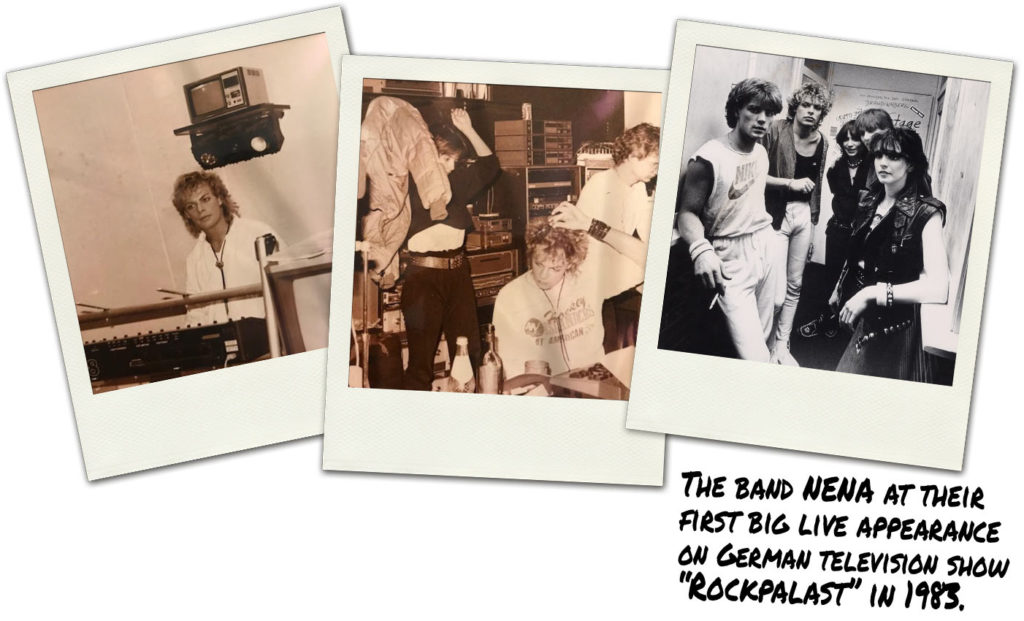
Musicians:
Rolf Brendel: drums
Jürgen Dehmel: bass
Uwe Fahrenkrog-Petersen: keyboards
Carlo Karges: guitar
Gabriele Susanne Kerner: vocals
Recorded:
SPLIFF Studio Berlin-Moabit,
autumn/winter 1982
Mixed:
Audio Studio Berlin-Lichterfelde
Mix Engineer: Udo Arndt
Technical Team:
Producer: Reinhold Heil, Manfred Praeker
Sound Engineer: Imre Sereg
The story of the legendary band NENA (1982-1987)
the most internationally successful line-up in the history of German pop music
The story of the band NENA is a tale of success unlike any other in the annals of German pop.
The early 80s saw the emergence of a new German language pop music culture, centred on West Berlin, that for quality and innovation could finally hold its own with Anglo-American imports. This was the “Neue Deutsche Welle”(New German Wave), which revolutionized the stuffy, traditional German media landscape. For the first time young German bands were breaking into the charts and reaching a wider audience. Bands like IDEAL and the Nina Hagen Band (later SPLIFF) were finally making pop songs with German lyrics respectable. Innovation was the order of the day. Two of these aspiring young musicians were Uwe Fahrenkrog-Petersen (synthesizer) and Jürgen Dehmel (bass) in Berlin. At the end of the 70s they had notched up their first local successes and produced their first LPs with their bands ODESSA and KATIA. They were now, at the start of the 80s, looking for their big break in the booming Berlin music scene.
It came from an unexpected source. In the winter of 1980/81 Uwe was offered a gig as keyboard player on a short club tour with THE STRIPES, a young ensemble from the provincial West German city of Hagen who had released an album in English with record label CBS. The album had flopped and the band had fallen out. But CBS was impressed with vocalist Gabriele Kerner (whose nickname was “Nena”) and wanted to give the young singer another chance, this time with songs in German. The plan was to send “Nena” Kerner – and her boyfriend, Stripes drummer Rolf Brendel – to Berlin to test the waters with the Spliff musicians, the producing team of Reinhold Heil and Manne Praeker, and their legendary manager Jim Rakete. But first the pair had to complete a ten day provincial tour with the ‘ ‘ Stripes‘ English repertoire, and for that they needed a keyboard player capable of modernising the Stripes sound. A number of musicians recommended Uwe Fahrenkrog-Petersen, who already had a reputation in Berlin as an innovator. The first meeting between “Nena” Kerner, Rolf Brendel and Uwe took place in the winter of 1980/81 in an unheated flat above a shop in Berlin Schöneberg, in which the cash-strapped Stripes pair had stayed the night. It was a collision of two worlds: “Nena” and Rolf were provincial kids from Hagen in home-knitted pullovers, while Uwe epitomised the extrovert style of the 80s Berlin music scene. Uwe was sceptical, but accepted the gig because he needed money to buy a decent case for his synthesizer. That short tour, however, convinced Uwe of the huge potential that was slumbering in the Stripes line-up. He could see for himself the remarkable effect “Nena” had on audiences in the live gigs. So when “Nena” and Rolf needed a potential hit single to launch their collaboration with the Spliff production team, Uwe wrote and produced the music for two songs in early 1981.
The two songs Nur geträumt (Just a Dream) and Ganz oben (Right on Top) were conceived by Uwe as minimalist, electronic pop compositions, and they were to become the template for the later sound of the band. “Nena” and Rolf were excited by Uwe‘s compositions and, although they had never written songs in German before, they came up with two great sets of lyrics. Spliff, Jim Rakete and CBS, recognising a potential hit, gave the green light to produce a single. There were now three core band members for the new project – Uwe, “Nena” and Rolf – but they were still missing a guitarist and a bass guitarist. On bass, Uwe recommended his old friend, the talented multi-instrumentalist Jürgen Dehmel. Jürgen fitted in perfectly straight away and went on to give the band many valuable artistic impulses. Finally, they were joined for the studio recordings by a friend of “Nena” and Rolf, the experienced lyricist and guitarist Carlo Karges, who had played in numerous bands including NOVALIS, EXTRABREIT and ULLA MEINECKE.
The line-up was thus complete and Rolf and “Nena” moved to Berlin, first moving in with Uwe, so they could work together on more songs. In a development that would soon pay dividends, Jürgen and Uwe provided access to ODESSA’s fully equipped rehearsal studio in Berlin-Charlottenburg, where the band could work and rehearse every day.
But the band didn’t yet have a name … So for want of a better idea – and because it would be easy to remember – the band members and their manager Jim Rakete decided to adopt vocalist Gabriele Kerner’s nickname “Nena” as the band name. In that they were following a precedent: Debbie Harry and BLONDIE. Everyone involved in the decision was aware that it could lead to confusion: audiences might assume the name NENA referred to a solo artist, rather than the band as a whole. But they were confident that any such misconception could be corrected in public by clear information in the press. That turned out to be a fatal error of judgement. So the band was launched with Rolf Brendel (dr), Jürgen Dehmel (bass), Uwe Fahrenkrog-Petersen (keyb), Carlo Karges (gt) und “Nena” Kerner (voc) as NENA in spring 1982, with their first single Nur geträumt (music: Uwe Fahrenkrog-Petersen / lyrics: “Nena” Kerner/ Rolf Brendel). At first, the disc didn’t exactly fly off the record shops‘ shelves. Then a lucky break came in the summer. The last minute withdrawal of another act freed up a slot on a TV music show called MUSIKLADEN (music shop) dedicated to the New German Wave. The hungry young band seized their chance, totally upstaging the established competition. By the next day, Nur geträumt by NENA was sold out everywhere and raced to the top of the charts. In the meantime the band had been working on new songs and already had enough material for an album, which they completed within just 3 weeks in autumn/winter 1982, again with the Spliff production team of Reinhold Heil and Manne Praeker in the Spliff Studio in Berlin-Moabit. Five songs and most of the lyrics on the album are from the hand of Carlo Karges – Vollmond (Full Moon), Es regnet (It’s Raining), Indianer (Indians), Ich bleib im Bett (I Stay in Bed) and Noch einmal (Once Again) – while the music for the single-releases 99 Luftballons, Nur geträumt and Leuchtturm (Lighthouse) was composed by Uwe Fahrenkrog-Petersen. But every member of the band contributed songs and ideas: “Nena” and Uwe together wrote Nur geträumt and Leuchtturm, Uwe and Rolf Brendel wrote Zaubertrick (Magic Trick), and Rolf by himself Kino (At the Movies) and Lass mich dein Pirat sein (Let Me Be Your Pirate), Jürgen Dehmel co-wrote Satellitenstadt (Satellite City) with Carlo and Tanz auf dem Vulkan (Dance on the Volcano)with “Nena“ and Carlo. The band had grown as an organic whole, in which each member was artistically on an equal footing, contributed to the repertoire and had an irreplaceable function: Carlo was the band’s soul, Uwe its musical brain, Jürgen the artistic tinkerer, Rolf the steady pulse and “Nena” the band’s face and voice. The first album under the band name, with the simple title “NENA”, was released at the start of 1983 along with their second single 99 Luftballons.
That song, a musically and textually groundbreaking anti-war song, was an instant hit on radio and went straight to the top of the charts, even surpassing the phenomenal success of its predecessor Nur geträumt. The band’s success now spilled over into neighbouring countries, with a sold-out European tour and a flood of Gold and Platinum discs from all over Europe. Thanks to the single’s international success, the NENA LP also topped the charts and turned the band into superstars. At the same time, however, it became harder to explain in each country that NENA was the name of the band and not of the solo vocalist. Internally, the band and manager Jim Rakete held solidly together and decided as a countermeasure to authorise no more individual photos of band members. The band’s punishing workload, trekking almost daily across Europe for TV appearances and tours, didn’t stop them recording a terrific second album entitled “?” (Fragezeichen – Question Mark) in autumn/winter 1983 with the Spliff team in Berlin. Once again, the music of the album’s hit first single– the title track “?” – was composed by Uwe Fahrenkrog-Petersen, with lyrics this time by “Nena” Kerner. And once again, the album topped the charts, not just in Germany but other European countries, and the European tour that followed in 1984 became a triumphal procession for the band.
By now even Uncle Sam was sitting up and taking notice: in Los Angeles Rodney Bingenheimer, the renowned DJ of KROQ Radio Station, had played 99 Luftballons (in German!) on his show and received such instant positive reactions that he added it to his playlist. From there the song was taken up by some of the big college radio stations, as its anti-war theme resonated with young Americans. The big breakthrough came with the TV film The Day After, the first drama on US television to offer an unsparingly realistic portrayal of nuclear war between the superpowers and the catastrophic aftermath. The TV channel followed the movie with the video of 99 Luftballons and the song had such an impact on viewers that, though not officially on sale in the US, it made it into the US Billboard Charts as an import. Now the US record label EPIC became aware of the song, and an official single version – A-side in English, B-side in German – and an album of songs from both the band’s LPs were released. In no time at all the single and the album conquered the US hit parade – the single even achieving Gold Status (over 1 million sales). The band NENA’s success in the US was now the starting signal for the rest of the world. From Australia via Japan and Asia to South America, 99 Luftballons topped the charts in 52 countries. Even in Great Britain, where there was a tendency to look down on German artists, the single held number 1 in the official charts for three weeks. This worldwide success, with constant tours and TV appearances (in the UK, France, Japan, to name just a few) naturally had an impact on the band members. They were now international stars, sharing a stage on a daily basis with the great British and American superstars like Prince, Duran Duran and Phil Collins, and that exposure opened them to new musical influences – to which German audiences at the time were not always able to respond. So the band’s third album Feuer und Flamme (Fire and Flame), produced by Reinhold Hell in London, Berlin and Ibiza, with the single Irgendwie, Irgendwo, Irgendwann (Anyplace, Anywhere, Anytime) by Uwe Fahrenkrog-Petersen and Carlo Karges, though still a commercial success, seemed over-elaborate and over-produced by German standards and thus less palatable for many fans.
And after nearly three years of non-stop media coverage in the press and on TV, the public had reached saturation point, something for which the band was not to blame, having done everything in their power to avoid press “overkill”.
Though the band continued to enjoy success away from Germany– Uwe Fahrenkrog-Petersen working in Los Angeles as a songwriter for Prince‘s Management, for example – they decided to retreat, far from the paparazzi and the fans, to a studio in northern Italy, to reconnect with their musical roots. There they produced – mostly in-house in collaboration with Klaus Voor mann ( nicknamed „The Fifth Beatle“) – the album Eisbrecher (Icebreaker). Though the album was a genuine return to the band’s core qualities and contained two typical NENA band classics in Jetzt bist du weg (Now You Are Gone), music by Uwe Fahrenkrog-Petersen and lyrics by “Nena” Kerner, and Zusammen (Together), music and lyrics by Carlo Karges, it wasn’t a big hit measured against earlier sales. The music had the same quality, but somehow the band had lost rapport with its fans. The press now responded by outdoing themselves with malicious stories about the band. Uwe, Carlo, Rolf, Jürgen and “Nena” felt deeply misunderstood. They had not given of their time and talents in order to be exposed to such malice. But such a turn of events is typical of such a meteoric international career. It woulhave been the right moment for good advisers to tell the band to take time out. But by that stage, good advice was exactly what was missing in the band’s immediate circle. The band didn’t really split up. Each just went his or her own way. Unsurprisingly, the band’s vocalist “Nena” Kerner was able to follow a proven business model of the time, being contracted by record label CBS as a solo artist. She adopted the band name for her solo career, which today still results in the band NENA‘s international success being misleadingly credited to the solo artist “Nena” Kerner, despite the fact that all the big hits (Nur geträumt, 99 Luftballons, Leuchtturm and Irgendwie, Irgendwo, Irgendwann) were created by the band as a whole. Without Uwe’s instinct for hit-songs and the band’s special chemistry, “Nena”struggled at first as a solo artist to pick up the threads of the band’s earlier success. Carlo Karges tried again and again to reunite the band. He died in 2002, and at his funeral, partly as a tribute to Carlo, Uwe and “Nena” hatched plans to re-record the band’s old hits, this time with “Nena” Kerner as solo artist. Uwe arranged and produced the album “Nena feat. Nena” in Berlin and Bremen (with co-producer/mixer Jeo Mezei) and it became one of the big hits of 2002, even outstripping the sales in Germany of the original NENA band album. The phenomenal success of that remake of the NENA band’s earlier songs was – and still is – the foundation for “Nena‘s” subsequent career as a successful solo artist.
Then in 2005 Uwe Fahrenkrog-Petersen produced “Nena‘s” first successful solo studio album with the title Willst du mit mir gehn (Will You Go With Me?) with co-producer/mixer Jeo Mezei. For that album Uwe Fahrenkrog-Petersen and “Nena” Kerner wrote the two biggest hits of “Nena’s” solo career: Willst du mit mir gehn and Liebe Ist (Love Is).
As the highlight of her solo concerts “Nena” continues to sing the hits of the NENA band era, accompanied by a changing line-up of top-notch American and German studio musicians and also by her children. It is a tribute to – and recreation of – the extraordinary moment in time when Rolf, Jürgen, Uwe, Carlo and “Nena” from Berlin did something no one in Germany had thought possible – and no one in Germany has achieved since. Together they conquered the whole world of pop music.
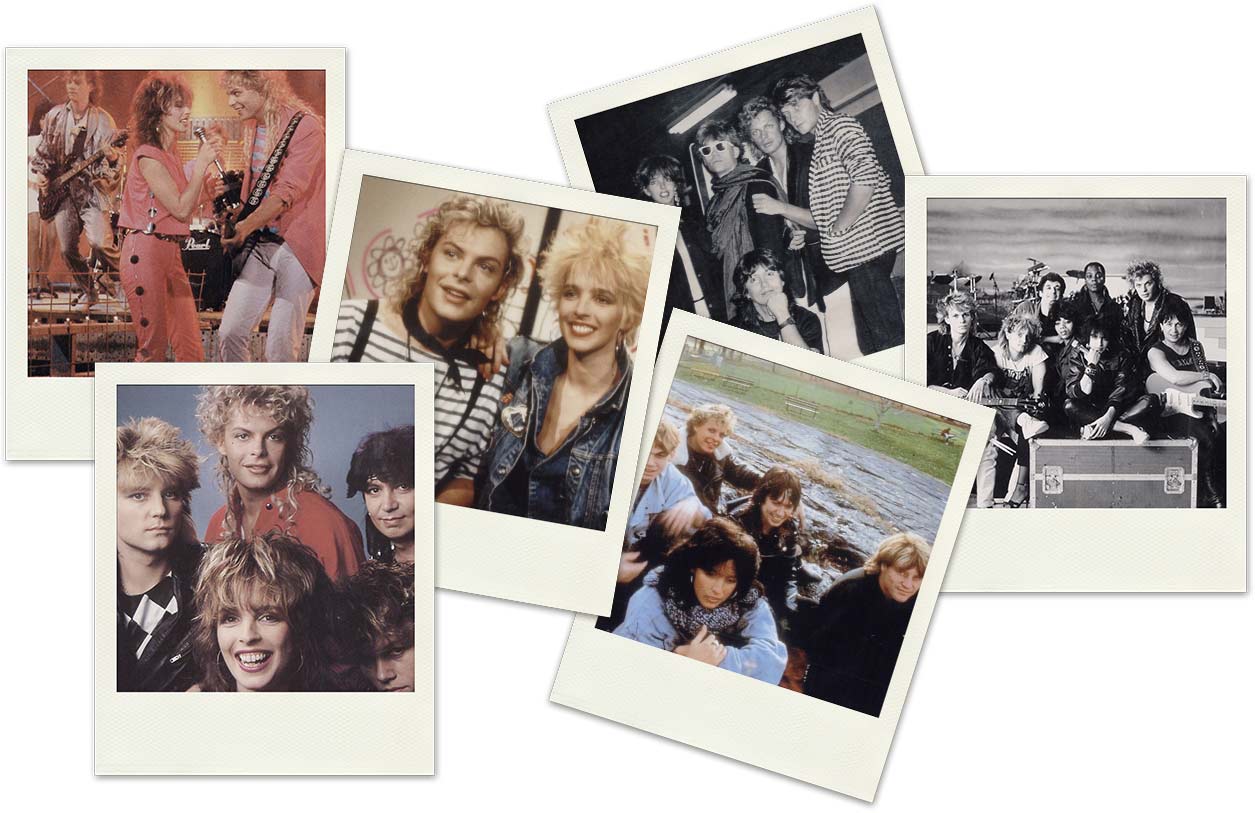
Awards and record sales:
99 Luftballons by the band NENA and the English version 99 Red Balloons were honoured with Single Gold Discs from the US, Great Britain, France, Canada, the Netherlands, Denmark and Germany in the 1980s. The song was also included in more than 40 international Gold and Platinum albums.
Since then a number of cover versions and “Best of” NENA band albums have been released, and the song continues to be one of the most frequently streamed German pop songs on Amazon, Spotify and Apple Music. Altogether 99 Luftballons/99 Red Balloons has achieved over 10 million physical and digital sales.
The former band members today
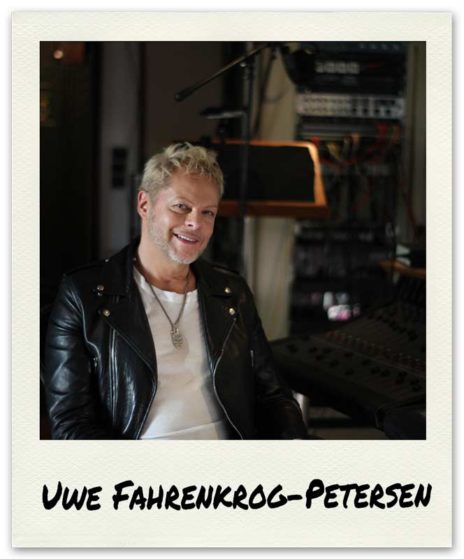
is an internationally successful composer and producer, based once again in his home city of Berlin and engaged on large-scale musical projects that fuse music and spectacle into unforgettable experiences.
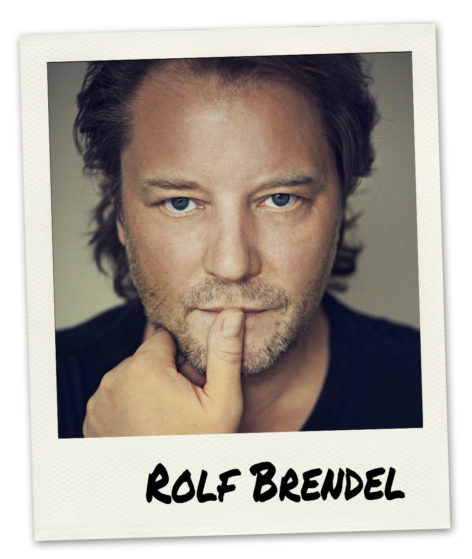
lives close to the North Sea coast at Cloppenburg, as he has done for the last 8 years. Through his open window he can almost hear the cry of the seagulls. Some prophetic impulse in the 80s made him write a NENA song called Kino (At the Movies). Ten years later he met Anja (now his wife), who ran the local cinema in Cloppenburg. He decided to stick around … He plays drums with friends in various bands and has a little sound studio where he continues to write music and lyrics – 80’s style songs – when he’s not busy helping coach the local schoolkids‘ band. In 2014 he published his memoir: NENA – Story of a Band.
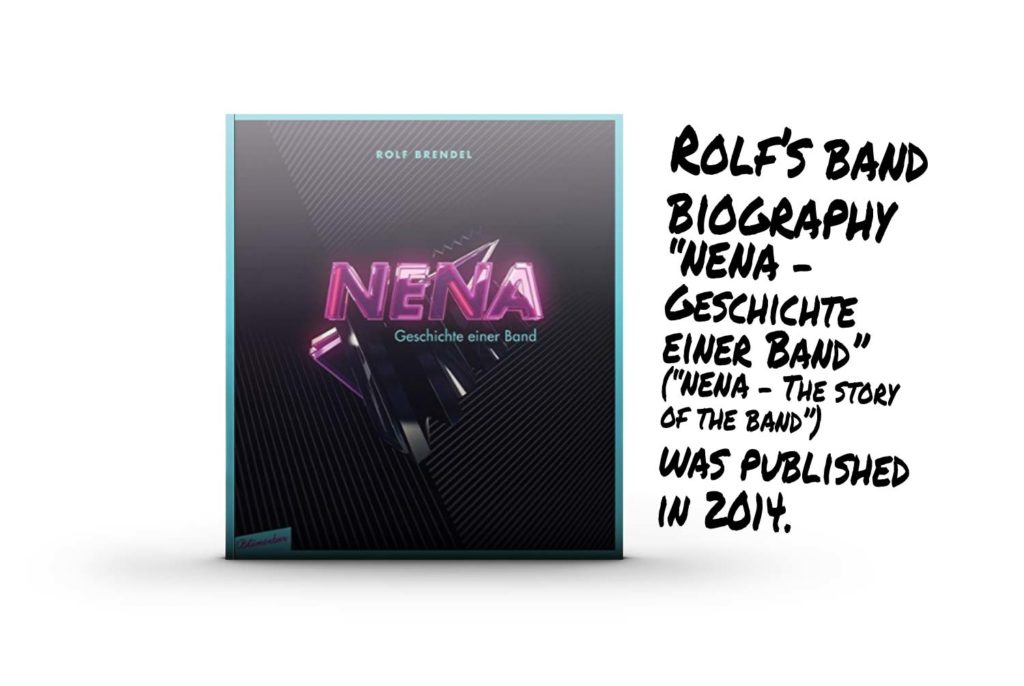
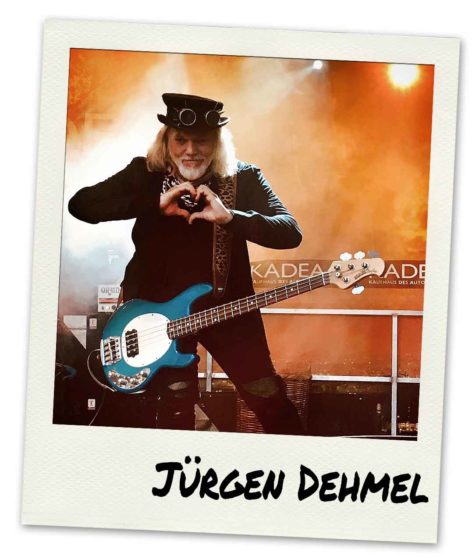
has remained true to his musical home of Berlin. He collaborated once more with Uwe Fahrenkrog-Petersen on Terra X: Atlantis and with “Nena” Kerner on Wunder geschehen (Miracles Happen) and on various children’s albums. He has toured the world with Nina Hagen and is still active as producer, composer, and studio and live musician with bands including Zwanzich15, Sherman Noir & The Highway Surfer and Bernward Büker, and as a regular guest on numerous other projects. As a hard core rock bass guitarist, he remains a force to be reckoned with, not just in the Berlin musical scene. His spare time he spends with family and friends in nature and by the sea. He is still a tech geek and enjoys flying his drone around and about, especially over the roofs of Berlin.
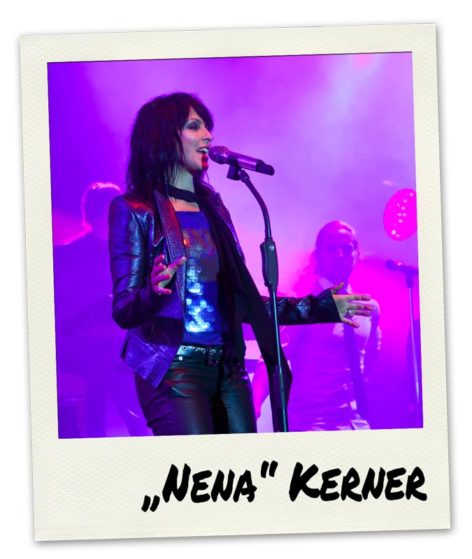
went solo when the band split in 1987 and, thanks to the success of the solo album Nena feat. Nena (2003), with its remake of the NENA band’s greatest hits, has since built a successful career as a solo artist, touring and recording, and as a fashion icon and TV presenter.
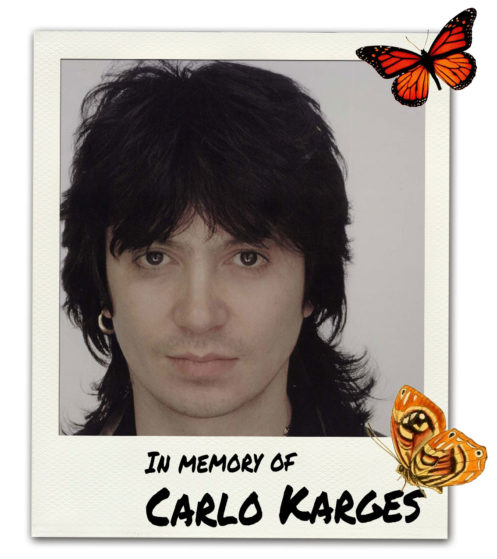
Carlo died in 2002.
He was a brilliant, inspired songwriter and guitarist, not just for NENA, but for other bands like NOVALIS, EXTRABREIT, RAMBLERS, TOMORROW’S GIFT, ULLA MEINECKE and BLEIBTREU REVUE. Among other songs, he wrote the lyrics for 99 Luftballons and Irgendwie, Irgendwo, Irgendwann (both for NENA) and Wer Schmetterlinge lachen hört (Who Hears Butterflies Laughing) for NOVALIS. Above all he was a deep, loving, valuable human being, a true friend, and a great rock ’n’ roll poet. He will not be forgotten.
On the song’s socio-cultural significance
by Dr. Lutz Fahrenkrog-Petersen, Executive Director, Research Centre for Popular Music Humboldt University Berlin
Terms like “finger on the pulse”, “trend”, “fashion”, “mirror of society” are used to describe a phenomenon of an earlier era as especially relevant to that particular moment in time. But such platitudes fail to capture the depth of the connection between the makers of music and the environment they inhabit. An environment to which they must fully belong if they are to express, clearly and honestly, the most pressing concerns of those around them – and of those further off but within their cultural orbit. 99 Luftballons was a hit not just because it was a great song, but because it conveyed an essential truth – a truth that can be expressed outright only in music, without political calculation, without tactical ambiguity.
This was a song that seemed to come from a meeting of minds – between a group of musicians and the public. This was a song that had to be written, and its message was crystal clear: Don‘t blow up our world, or there’ll be nothing left!!
Both Carlo Karges and Uwe Fahrenkrog-Petersen inhabited an environment tinged with fear – the fear of being crushed between two superpowers. As songwriters, they chose neither the didactic tone of earlier protest songs nor the virulent “fuck you” attitude of punk, with its declared aim of the overthrow of capitalism. The route they took was simpler, more direct, and free of violence or vitriol. Though Carlo‘s lyrics have a childlike ring, they are razor-sharp and cut straight to the chase: “99 Kriegsminister, Streichholz und Benzinkanister…” (99 Ministers of War, armed with matches and a can of petrol).
The music, too, radiates confidence, much more than it does an oppressive melancholy. As a composition it is made of three distinct parts, each in stark contrast to the others in tempo and rhythm, but the thread is never lost. The quick changes from solemn meditation to optimism elevate it to the level of contemporary programme music.
And one thing was clear to the public: the song expressed what they were thinking, in the way that they would like to hear it said – please don’t take away our future!
The longing for a future was particularly strong in the devastating aftermath of the Second World War and the Vietnam War, particularly against the background of a potential nuclear conflict that hung in the air. The TV film The Day After brought nuclear apocalypse straight into American living rooms, following it immediately with the music video of 99 Luftballons. The song thus became associated worldwide with the fear of nuclear disaster and the yearning for a future, and that connection still holds good today. Film makers in particular like to play the song to evoke the Zeitgeist of the 80s, since its frequent airing and continuing popularity have made it exemplary of that era, reflecting the degree to which the song became embedded in the collective consciousness of the 1980s. It was especially popular on the campuses of colleges and universities, thus placing the band in the same bracket as REM or Bob Dylan. Thus emerges an interesting gap between reality and perception. In Germany the band NENA was a classic pop act that first made its name with Nur geträumt (Just a Dream), a song far removed from the political activism of a Michael Stipe or Bob Dylan. In the US, perception of NENA the band and the song 99 Luftballons was radically different. There the band were directly identified with the message of the lyrics as understood in the context of the film, and thus with the active peace movement. So the song exists on two parallel and interdependent levels: on the one hand, its daily exposure as a radio pop hit; on the other, the layers of meaning that resonated on a deeper level with its listeners.
We often ask ourselves why this or that song is still listened to decades later, or why so many other hits are quickly forgotten. The answer lies partly in the degree to which a song was genuinely relevant to contemporaries at the time, and how much that relevance will be acknowledged by later generations, enhancing a song’s reputation as a connecting link between then and now.
Not all forgotten songs were bad, they just weren’t that important. 99 Luftballons was that important, and always will be.
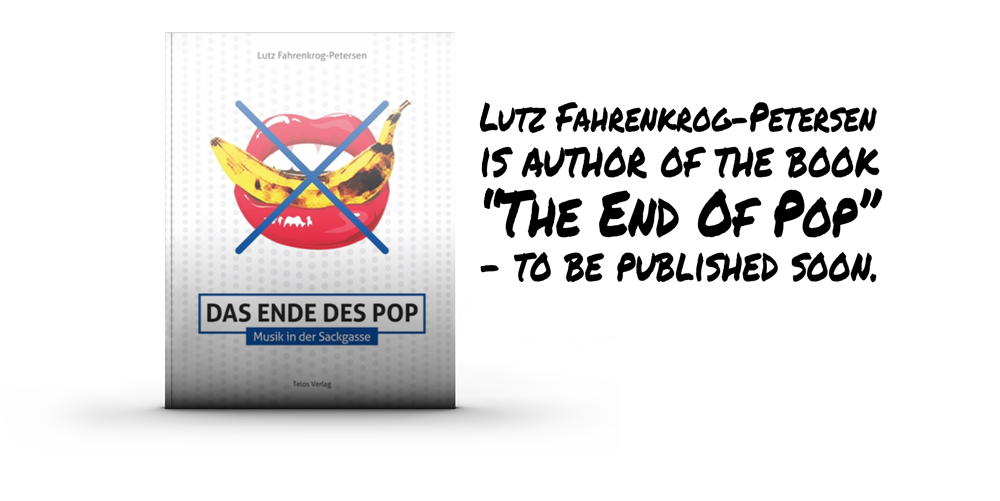
The song today:
Internationally, 99 Luftballons is the most successful German pop song of all time, and is regarded as a seminal style icon of the 1980s. For more than 30 years, until the present day, it has been celebrated in movies, TV shows and commercials all over the world.
Videos of the song:
Interpretations by other artists:
The song has been re-interpreted many times by artists of international stature. Here is a selection:



